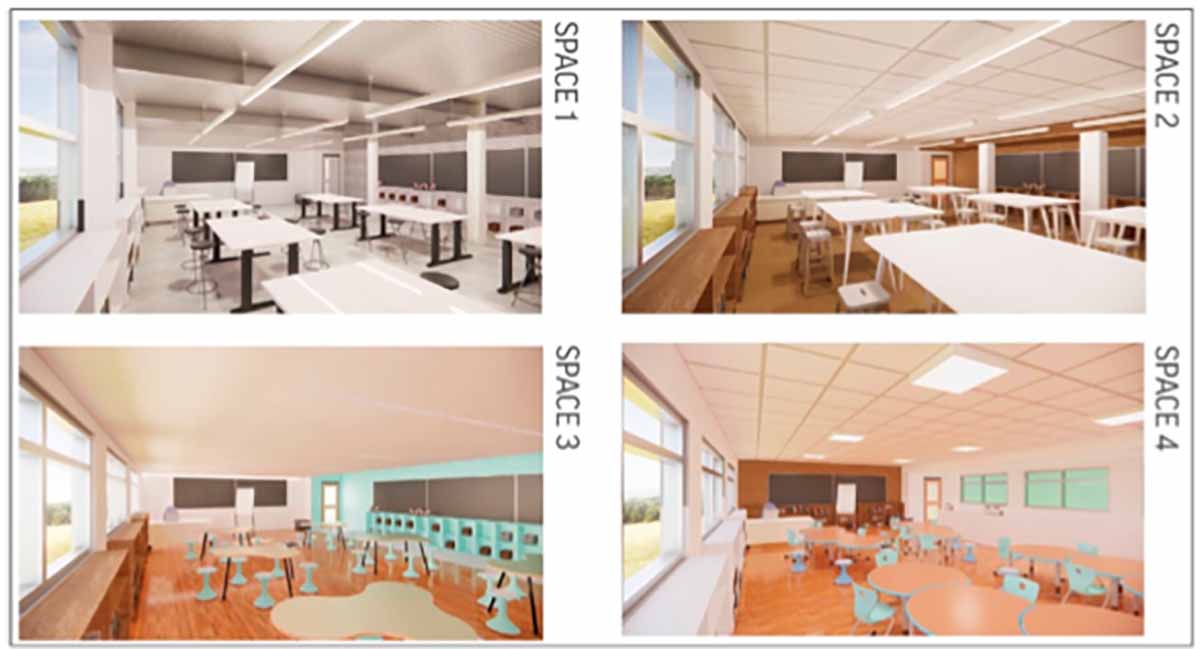Study finds students, designers have different perceptions of masculine, feminine traits of classrooms, influence on belonging

LAWRENCE — The way people interact with the built environment can influence whether they feel comfortable in a space or if they feel they belong among people who gather there. But the people who design learning spaces and those who use them might not feel the same about them.
A new study from the University of Kansas finds that students and classroom designers had different perceptions of the masculine and feminine traits of classroom spaces and how those features influenced their sense of belonging therein.
Researchers asked undergraduates and classroom design professionals about their perceptions of classrooms with design features classified as masculine and feminine, finding they had strong, opposite correlations between their perceptions of femininity and sense of belonging in the spaces. The authors said the findings emphasize the need for better understanding of how students perceive learning spaces and how learning spaces can foster a sense of belonging.
Studies have shown that how students perceive learning spaces influences their sense of belonging and that when they feel they belong they have better educational outcomes. But little work has been done on specific design features and how people perceive them as being associated with masculinity or femininity and how such traits influence their sense of belonging in classes conducted in the rooms that include them. In two new studies, researchers surveyed undergraduates and design professionals about their reactions to four learning spaces.
“We say masculine and feminine and those conjure images in people’s minds, but not necessarily the same images from person to person,” said Michael Ralph, vice president and director of research with Multistudio, one of the study’s authors. “When we asked students and designers about the same spaces, we didn’t see a small difference in perception. Their thoughts were very different. I think that emphasizes there is an important personal component about how we interact with these spaces.”
Cheryl Wright, lecturer specializing in best practices in learning in KU’s School of Education & Human Sciences and a study co-author, said she regularly sees the difference a classroom makes in how students engage with a class. When students learn about polarizing topics that can be personally or politically charged, those who are not comfortable in the space may not feel like they belong in a discussion.
“We definitely want to have interactions and dialogue where people feel safe. We don’t just mean physically safe, but safe to share their thoughts,” Wright said. “On topics that are difficult to discuss, the space in which they learn is critical.”
The researchers addressed their questions in two studies. For the first, they collected data from undergraduates at five institutions of higher education across the United States. In the second, they collected data from professionals at design firms across the United States and Canada.
Respondents were asked to share their reactions to four computer-generated images of classrooms meant to strongly evoke masculinity with features such as black and white color palettes and angular/linear space features or femininity with soft colors, additional windows, curvilinear tables and shifts away from dark woods. Other spaces incorporated those features to a lesser extent.
Respondents were shown one of the four spaces at random and asked how much they felt 14 one-word prompts were associated with the shown space. They were then asked four questions about how much they felt they would belong in that space. Results showed the students’ perceptions of feminine traits in the rooms coincided with a higher sense of belonging, but perceptions of femininity among professionals coincided with the opposite — a lower sense of belonging.
The study, written by Ralph, Wright, Julia Pascutto, design director with Lemay x FLDWORK, a Canadian design firm; and Rebecca Pedrosa Martinez, a designer at Multistudio during the study, was published in the Journal of Interior Design.
The authors said that student respondents who reported feeling a sense of belonging in the more feminine spaces was represented across genders.
The authors also found that there was not antagonism toward the more masculine spaces, or responses of feeling that they would not belong there — only that their sense of belonging was higher when they perceived more femininity in a space.
The fact that students and design professionals had opposite reactions in terms of their perceptions of the class environments shows that architects, designers and others who shape and create learning environments for others cannot assume their designs and choices will resonate with others the way they do with themselves. And those choices could potentially reinforce negative hierarchies or make some students feel unwelcome or uncomfortable, Ralph said.
For their part, educators are often assigned a room in which to hold their classes and cannot control design elements such as how many windows a room has, their placement, paint colors or if furniture is affixed in place. However, they can influence how students interact with each other and teachers in a space, such as encouraging collaborative groups or moving furniture to encourage discussion when possible.
“A sense of belonging has to be intentional. I want students to have a transformational education,” Wright said. “Students come in with different backgrounds and life experiences. For me, it is critical that we form a sense of belonging. And my students have said they feel more comfortable discussing controversial or difficult issues in spaces that facilitate them.”
The study also adds to a body of research showing that students will select to take certain classes based on the type of room it is offered in, that women tend to prefer active learning spaces to traditional lecture halls and similar studies Ralph and KU colleagues have conducted.
“We want to learn more about what we can do to make a difference in design, in terms of learning spaces, student housing and across the built environment and what makes good design that helps students feel like they belong,” Ralph said.